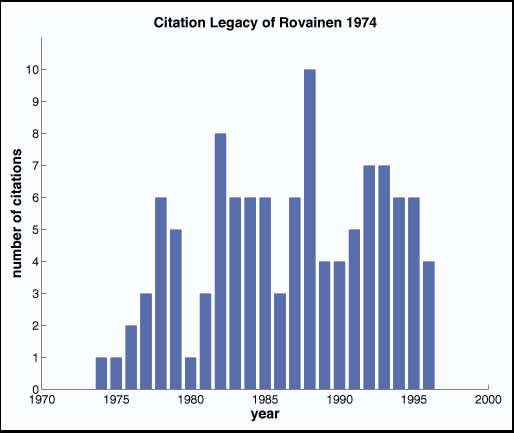

The neurobiology of lampreys has a literature that reaches back to the late 1800s. Much of the early work in spinal cord neurophysiology was done in the United States by Carl Rovainen of Washington University in St. Louis Missouri. It's difficult to pick out one particular "classic" for the neurobiology of swimming in lamprey, as it was through a slow accretion of information that it has become the outstanding system it has become for understanding vertebrate locomotion. I've selected Rovainen 1974 as it is one of the earliest papers that most contemporary treatments of the neural basis of lamprey swimming consistently cite. This paper discusses the synaptic interactions of Müller and Mauthner neurons, both very important as they are some of the very few neurons that can be individually identified in vertebrates. Individual identification of neurons (i.e. the neuron has a size, position, and/or other features such as color that allows the same neuron to be located in different animals) is usually restricted to invertebrates with their large cells, and is a property that makes cumulative studies on the function and properties of neurons much easier.
There have been a total of 110 citations of this paper from the time of its publication in 1974 to November 1996, for a mean rate of 5 citations per year. The majority of articles were on aspects of the neural organization of lamprey spinal cord, examined with techniques of pharmacology, histology, immunohistochemistry, and electrophysiology. A good number of these used "fictive" swimming. This occurs in isolated spinal cord preparations of the lamprey, and it means that the neural activity corresponds closely to what one would see in the intact animal performing the behavior. This is a powerful experimental technique usually only possible with highly stereotyped rhythmic behaviors such as locomotion, breathing, and feeding. There were also several reviews of rhythmic behavior or locomotion. The article has seen some dispersion beyond the confines of the neurobiology of lampreys: one paper on the organization of the spinal cord of the weakly electric fish, Gymnotus carapo, one on the Mauthner cells of goldfish, one comparing dogfish and lamprey spinal mechanisms for locomotion, one on regeneration of neuromuscular connections in the crayfish, one on the lateral vestibular nucleus of a toadfish, and one review on the lamprey brain from a comparative perspective. The majority of journals of the citing papers were in neuroscience, with a few in clinical neurology, as the work on lamprey spinal cord is important to investigators of the human spinal cord. Several papers on evidence of regeneration of lamprey spinal neurons are particularly relevant to clinicians. An interesting methodological thread was several earlier articles on the development of isolated CNS preparations, a technique that is increasingly common. Slightly over 30% of the 110 papers citing this paper were authored or co-authored by Sten Grillner, a key figure in contemporary neuroscience of locomotion as studied with the lamprey.
